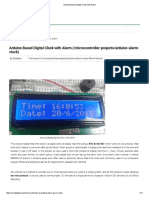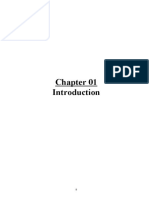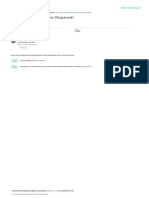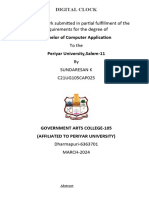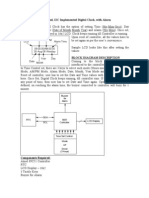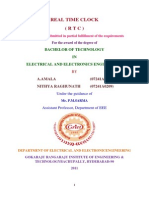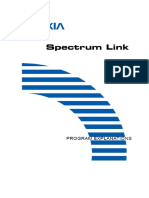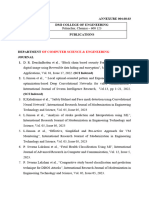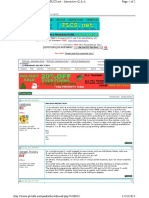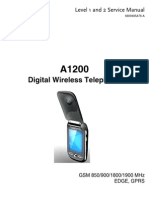DEPARTMENT OF
ELECTRONICS AND COMMUNICATION ENGINEERING
College of Engineering and Technology
SRM Institute of Science and Technology
MINI PROJECT REPORT
ODD Semester, 2024-25
Lab code & Name : 21ECO106J- Embedded system design using Arduino
Year & Semester : III Year, V semester
Project Title : Dual Alarm clock with Temperature Display
Course Teacher : Dr. R.Senthil Kumaran
Assistant professor
Electronics and Communication Department
Team Members :
Reg. No
Mark split up RA2211003010166 RA2211003010241 RA2211003010294
Novelty in the project work
(10 marks)
Level of understanding of the design
formula(5 marks)
Contribution to the project
(5 Marks)
Report writing (10 Marks)
Total (30 Marks)
Date: Signature of Course Teacher
1
� DUAL ALARM CLOCK WITH DATE AND TIME ADJUSTMENT
OBJECTIVE:
The objective of this project is to design and implement a Dual Alarm Clock with Date
and Time Adjustment using an Arduino Nano microcontroller and an I2C LCD
Display. This project aims to provide users with a convenient and efficient way to set and
manage alarms, display the current date and time. By incorporating an I2C interface, the
project achieves a more compact and efficient display connection, reducing wiring
complexity.
ABSTRACT:
This project presents the development of a Dual Alarm Clock with Date and Time
Adjustment utilizing an Arduino Nano microcontroller and an I2C LCD Display. The goal
of the project is to create an efficient and user-friendly digital clock that allows users to set
and manage two independent alarms, view the current date and time, and adjust these
settings as needed. The use of the I2C LCD Display minimizes wiring complexity and
conserves microcontroller pins, making the design compact and streamlined. The system is
designed to keep accurate time and enables users to set alarms for different times, catering
to varied scheduling needs. Additionally, a Real-Time Clock (RTC) module is used to
ensure precise timekeeping, even in case of power interruptions. This project demonstrates
practical applications of embedded systems in daily time management and offers an
affordable, customizable solution suitable for home, office, and personal use.
INTRODUCTION:
In today’s fast-paced world, effective time management is essential, and alarm clocks play
a key role in organizing daily schedules. This project focuses on designing a Dual Alarm
Clock with Date and Time Adjustment using an Arduino Nano and an I2C LCD
Display. The system enables users to set and manage two independent alarms, view the
current date and time, and make easy adjustments as needed.The dual alarm functionality
allows for multiple reminders, catering to varied personal or professional needs. Using an
I2C LCD Display simplifies the hardware setup by reducing connections, making the
design more compact. An RTC (Real-Time Clock) module is integrated to ensure
accurate timekeeping even during power outages.This project demonstrates the application
of embedded systems in daily life, offering a customizable, affordable, and reliable dual
alarm clock solution for users, while also providing hands-on experience with
microcontrollers, real-time systems, and I2C communication.
2
�HARDWARE REQUIREMENT/DESCRIPTION:
● Arduino Nano
● DS3231 RTC Module
● 2004 LCD Screen with I2C module
● 4 X push button
● 1 X LED
● 1 X Buzzer
● 1 X 100 ohm Resistor
● 3V coin cell Battery
● Breadboard
● Jumper wires
CIRCUIT DIAGRAM:
Figure : 1
3
�DESIGN ISSUES:
● Real-Time Clock Battery and Time Loss
● Alarm Overlap Handling
● Power Consumption
APPROACH/METHODOLOGY:
The user can interact with the system using push buttons for setting time and date. When a
button is pressed, the system should respond immediately by either incrementing or
decrementing the corresponding time or date field (e.g., hours, minutes, day,
month).Provide clear feedback on the LCD to show which field is being adjusted, and
indicate the current mode (time or date adjustment).Use button presses to adjust time in
real-time, updating both the RTC and the LCD immediately.
RESULTS:
The DS3231 Dual Alarm Clock with Manual Date and Time Adjustment was successfully
developed using an Arduino Nano and an I2C LCD Display. The system met all project
objectives, providing accurate timekeeping, dual alarm functionality, and an intuitive user
interface for setting the time, date, and alarms. Key outcomes of the project are
summarized as follows:
● Accurate Timekeeping: The DS3231 RTC module maintained precise time with
minimal drift, even during power interruptions, thanks to the 3V coin cell battery
backup. The date and time displayed on the LCD were stable and accurate over
extended periods.
● Dual Alarm Functionality: The system allowed users to set and store two
independent alarms. Each alarm was activated at the specified time, triggering both
the LED indicator and the buzzer. This feature provided flexibility for setting
multiple reminders.
● Manual Date and Time Adjustment: With four push buttons, users could manually
adjust the date and time, providing ease of use without requiring a computer
connection or external software. The interface was intuitive, with clear instructions
displayed on the LCD for each adjustment function.
● Efficient Display with I2C LCD: The 20x4 I2C LCD Display effectively showed
the current date, time, and alarm status, using only two pins on the Arduino Nano
due to the I2C interface. This minimized wiring complexity and allowed for a clean
and organized setup.
● Visual and Audio Alarm Notifications: The LED and buzzer provided both visual
and audible notifications for alarms, ensuring the user is promptly alerted at the set
times. The buzzer sound was loud enough to be noticeable in most environments.
● Reliable and Compact Circuit Design: The project was built on a breadboard with
minimal wiring, making the circuit compact and easy to assemble. The use of
jumper wires and the I2C interface reduced the overall hardware complexity.
4
�CONCLUSIONS:
The DS3231 Dual Alarm Clock with Manual Date and Time Adjustment Using
Arduino Nano project successfully demonstrates the integration of real-time clock
functionality with manual control for setting time, date, and alarms. By combining the
highly accurate DS3231 RTC module, the versatile Arduino Nano, and an intuitive LCD
interface, the system offers a practical solution for managing daily schedules, reminders,
and time-sensitive tasks.
REFERENCES:
https://www.instructables.com/DS3231-REAL-TIME-CLOCK-WITH-I2C-LCD-AND-AR
DUINO-NA/
https://circuitdigest.com/microcontroller-projects/interfacing-ds3231-rtc-with-arduino-and-
diy-digital-clock
APPENDIX:
Arduino Nano :
Figure : 2
● A compact, versatile microcontroller board that acts as the main controller for the
project.
5
�DS3231 RTC Module :
Figure : 3
● - A highly accurate Real-Time Clock (RTC) module that provides reliable date
and time data.
LED :
Figure : 4
● LEDs are Light Emitting Diodes. They are super compact and do not emit heat ;
most commonly used in emergency lighting, automotive tail lights.
20x4 LCD Display:
Figure : 5
● A 20x4 LCD display with an I2C interface, allowing it to display time, date, and
alarm information with reduced wiring.
6
�Push Buttons :
Figure : 6
● A push button is a simple, momentary switch that allows a user to make a
temporary connection in an electrical circuit when pressed. It is typically used for
user inputs in electronic projects
Buzzer :
Figure : 7
● - An audio alert component that produces sound when an alarm is activated,
ensuring that users are notified at the set alarm times.
100 ohm Resistor :
Figure : 8
7
� ● A resistor to limit current, typically used with the LED to prevent excessive current
that could damage it.
3 volt coin cell Battery:
Figure : 9
● small, round, flat battery commonly used in low-power electronics, like watches or
small sensors, providing 3 volts of power.
Breadboard:
Figure : 10
● A tool for prototyping electronic circuits without soldering. It allows components
to be inserted and connected via metal strips under the surface.
Jumper wires:
Figure : 11
● Flexible electrical wires with connectors on both ends, used to make temporary
connections between components on a breadboard or circuit.
8
�DUAL ALARM CLOCK WITH DATE AND TIME
Kaavya Manohar – RA2211003010166
Farheen S– RA2211003010241
Mythili K – RA2211003010294
















